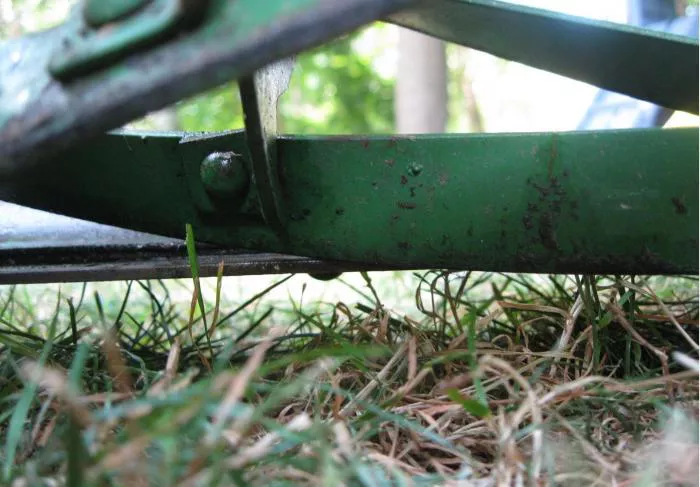A hand push lawn mower is a simple, eco-friendly tool that relies on sharp blades to cut grass cleanly. Unlike gas or electric mowers, it doesn’t require fuel or electricity, making it a quiet and low-maintenance option for small to medium lawns. However, dull blades tear grass instead of slicing it, leading to ragged edges that turn brown and invite disease. Sharpening the blades regularly ensures a healthier lawn, reduces mowing effort, and extends the life of your mower. This guide will walk you through the process step by step, making it easy for anyone to maintain their mower like a pro.
Why Sharpening Your Lawn Mower Blades Matters
Sharp blades make mowing easier and improve lawn health. When blades are dull, they rip grass, leaving uneven cuts that turn brown. Torn grass is more susceptible to disease and pests. A sharp blade slices grass cleanly, promoting faster healing and a neater appearance. Additionally, sharp blades reduce the effort needed to push the mower, making your job easier.
Regular sharpening also extends the life of your mower. Dull blades strain the mower’s mechanism, causing unnecessary wear. Keeping the blades sharp ensures smooth operation and prevents damage to other parts.
Tools You Will Need
Before starting, gather the necessary tools:
- Safety gloves to protect your hands from sharp edges.
- A wrench or spanner to remove the blade.
- A bench vise to hold the blade securely.
- A file or sharpening stone for manual sharpening.
- A wire brush to clean debris from the blade.
- A lubricant such as oil to prevent rust.
- A rag for wiping the blade.
Having these tools ready will make the process smoother and safer.
Step-by-Step Guide to Sharpening Your Hand Push Lawn Mower
Prepare the Mower
Start by cleaning the mower. Grass clippings and dirt can interfere with sharpening. Use a wire brush to remove debris from the blade and mower housing. Wipe the blade with a rag to ensure it is free of residue.
Remove the Blade
Most hand push mowers have a single blade attached to the center axle. Use a wrench or spanner to loosen the bolt holding the blade in place. Turn the bolt counterclockwise to remove it. Keep track of any washers or spacers to reassemble correctly later.
Once the bolt is removed, carefully take out the blade. Be cautious, as even dull blades can be sharp enough to cause cuts.
Secure the Blade for Sharpening
Place the blade in a bench vise to hold it steady. If you don’t have a vise, clamp it securely to a workbench. The blade should be stable to avoid accidents while sharpening.
Inspect the Blade
Check the blade for damage. Look for nicks, bends, or excessive wear. If the blade is severely damaged, it may need replacement. Minor nicks can be smoothed out during sharpening.
Sharpen the Blade
Hold the file or sharpening stone at the same angle as the existing edge. Most mower blades have a beveled edge between 30 and 45 degrees. Follow this angle to maintain the blade’s effectiveness.
Push the file along the edge in smooth, even strokes. Work from the base to the tip, applying consistent pressure. Avoid back-and-forth sawing motions, as they can create an uneven edge.
After sharpening one side, flip the blade and repeat the process on the other side. Ensure both edges are sharpened equally to maintain balance.
Balance the Blade
An unbalanced blade can cause vibration and uneven cutting. To check balance, hang the blade on a nail or screwdriver. If one side tilts downward, file a small amount of metal from the heavier side until it balances.
Clean and Reassemble
Wipe the blade with a rag to remove metal filings. Apply a light coat of oil to prevent rust. Reattach the blade to the mower, ensuring it is properly aligned. Tighten the bolt securely, but avoid over-tightening, which can strip the threads.
Test the Mower
After reassembly, give the mower a test run. Push it over a small patch of grass to ensure smooth operation. If the mower cuts cleanly without resistance, the sharpening was successful.
Tips for Maintaining Sharp Blades
Clean the blade after each use: Grass and moisture can cause rust and dull the blade faster. Wipe it down regularly.
Avoid mowing over hard objects: Rocks, sticks, and debris can damage the blade. Clear the lawn before mowing.
Sharpen blades at least once a season: Regular maintenance keeps the mower in top condition.
Store the mower properly: Keep it in a dry place to prevent rust and corrosion.
When to Replace the Blade
Even with regular sharpening, blades wear out over time. If the blade is too thin, cracked, or heavily pitted, it’s time for a replacement. A damaged blade cannot be sharpened effectively and may break during use.
Conclusion
Sharpening a hand push lawn mower is a simple yet essential task for maintaining a healthy lawn. With the right tools and techniques, you can keep your mower in excellent condition. Regular sharpening ensures clean cuts, reduces effort, and prolongs the life of your mower. Follow this guide to sharpen your blades properly and enjoy a well-manicured lawn all season long.
By taking the time to care for your mower, you invest in the beauty and health of your lawn. A sharp blade makes all the difference, turning a tedious chore into an efficient and satisfying task. Happy mowing!
Related topics:
- 3 BEST REEL LAWN MOWER WITH BAGGER
- HOW MUCH IS A USED PUSH LAWN MOWER WORTH?
- HOW TO FIX A LAWN MOWER CATCHER?

